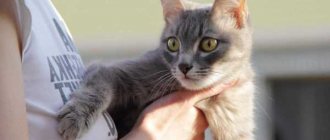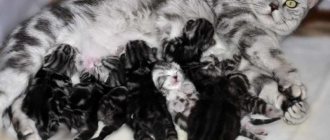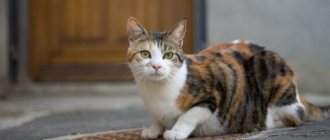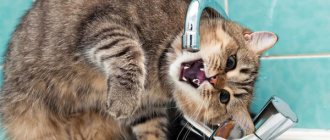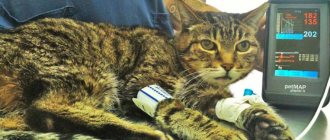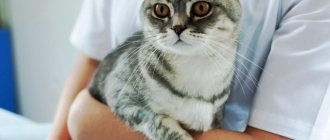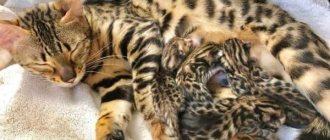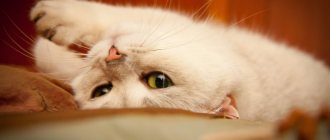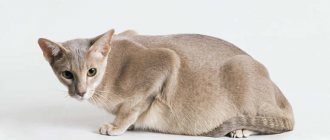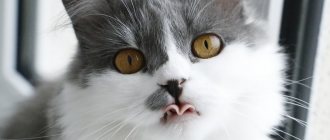Breathing is life. This is one of the reasons why cats and dogs with respiratory failure require quick and effective treatment. Experts at the Berloga veterinary clinic talk about what pulmonary failure is in animals, what symptoms it is accompanied by, and how therapy occurs.
Read in this article:
What is this?
Causes of pulmonary failure
How does DN manifest itself in cats and dogs?
When to ask for help?
How is respiratory failure treated in dogs and cats?
Initial stabilization
Diagnostics
Therapy
general characteristics
Shortness of breath in a cat is a common occurrence and can occur both normally and in many pathological conditions. The heart of a cat resembles the heart of a sprinter, that is, the structure and function of this organ is designed in such a way that it can work effectively under explosive physical activity, but for a short time. In dogs, on the contrary, the heart resembles the heart of a marathon runner, that is, this type of animal is able to withstand prolonged stress. Therefore, in a clinically healthy cat, after prolonged exercise, shortness of breath appears and this is the absolute norm. However, shortness of breath in cats can be a symptom of many diseases and pathological conditions.
What is this?
Respiratory failure (RF) in dogs and cats is a pathological condition in which the animal’s lungs do not provide normal blood gas composition or do, but it is achieved due to the intensive work of the external respiratory apparatus and heart, which reduces the functional characteristics of the body.
Important! Pulmonary insufficiency in cats and dogs is dangerous because without timely treatment it leads to acute and chronic diseases of the bronchopulmonary system, circulatory disorders, damage to the central nervous system and a number of other dangerous complications.
Causes of shortness of breath in cats
When a cat develops shortness of breath, the reasons can be varied. Here is a list of the main pathological conditions that manifest themselves and are characterized by this symptom:
- Heart failure
- Respiratory problems
- Pain
- Inflammation
- Infections
- Anemia
- Autoimmune diseases
- Injuries
- Accumulation of fluid in the pleural cavity
- Accumulation of air in the pleural cavity
- Lung tumors or neoplasms in the chest cavity
- Accumulation of large amounts of fluid in the abdominal cavity
It should be noted that this is not a complete list of diseases. Based on the above, the causes of shortness of breath in a cat can be varied.
Shortness of breath, breathing with an open mouth or wheezing in a cat
Orlova Maria Eduardovna anesthesiologist-resuscitator
Signs of a breathing disorder
:
- unusual sounds (wheezing)
- unusual posture, restlessness, inability to lie down
- pale or bluish discoloration of the gums and lips
- very rapid breathing or difficulty breathing, with visible effort when inhaling or exhaling.
- for cats: open mouth breathing
You could even say that if a cat breathes with its mouth open, it has serious problems.
.
The exception is fat cats who can afford to breathe with their mouths open after long games. Although, of course, an overly fat cat cannot be called completely healthy.
The body of land animals does not know how to create oxygen reserves
, so if any serious breathing problems occur, the lack of oxygen can very quickly become life-threatening. Therefore, if the animal has any breathing problems, you should not postpone a visit to the doctor. If the animal’s condition worsens, shortness of breath intensifies, lips and gums become bluish or purple - emergency assistance is required, minutes can count.
How to help at home
? The cat needs to be kept calm and not create additional stress on the respiratory system (it is vitally important not to agitate the cat, this can be very dangerous!). Under no circumstances should you try to put the cat down or give it water - this can be dangerous. There is no need to use any drugs that stimulate breathing - in most cases this is not only pointless, but can also be harmful. It is necessary to take the animal to the doctor as quickly and carefully as possible.
What will the doctor do?
? When providing first aid to a patient with difficulty breathing, the main task is to provide the body with oxygen. Sometimes it is enough to place the animal in an oxygen chamber or allow it to breathe oxygen using a mask, sometimes urgent surgery or artificial ventilation is required. Simultaneously with providing first aid, the doctor will conduct diagnostics, and his further actions will depend on what cause of breathing problems he discovers.
If the airway is obstructed
– air does not reach the lungs or is supplied in insufficient quantities. An obstacle to the passage of air may be a foreign object in the upper respiratory tract (a piece of food or plant), trauma to the upper respiratory tract (for example, a bite), or swelling of the tissues of the neck. To help a patient with obstruction of the upper respiratory tract, it is necessary to quickly ensure its patency - remove the foreign body, relieve swelling with anti-inflammatory drugs. In an emergency, tracheal intubation may be required (the doctor will insert a tube into the trachea through the mouth), or installation of a tracheostomy (in this case, the tube will be inserted into the trachea from the surface of the neck, below the “blocked” area). These procedures are performed under general anesthesia.
If the lungs are affected
, gas exchange is disrupted, and the blood is not saturated with oxygen. The causes of lung problems can be bruise due to injury, pneumonia (pneumonia), or pulmonary edema. In cats, shortness of breath may develop due to long-standing, untreated feline asthma. Such patients typically have rapid breathing that requires great effort.
It is also important to remember that cats can also suffer from heart disease.
. These diseases are typical for British cats and Sphynx cats. In this case, the initial problem is not in the lungs, but in the fact that the heart is not able to adequately pump blood through the vessels, because of this, stagnation of blood develops in the vessels of the lungs, and fluid leaks into the lung tissue. All patients with lung pathology usually require hospitalization, intensive treatment, sometimes for several days, and in severe cases, artificial ventilation.
Difficulty breathing may be caused by problems in the chest area
, such as severe rib fractures, fluid or air accumulation in the chest cavity. To help such a patient, the cause of the disease must be quickly eliminated. For example, a cat that has fallen from a great height often has free air in the chest cavity. It penetrates the chest cavity from the injured lungs and compresses them, making it difficult to breathe. In such a situation, the doctor must remove air from the chest cavity through a puncture of the chest wall. Sometimes it is necessary to install a drainage - a special tube through which accumulated air can be removed. As a rule, such patients also need to be monitored in a hospital.
Of course, what we have described is only a small part of the large number of reasons that cause breathing problems in our pets. It is important to remember that cats are animals with a very vulnerable respiratory system.
.
It can be quite rightly said that the lungs of cats are their weak point; the safety margin of the respiratory system of cats is very small. Therefore, any breathing problems in cats should be taken very seriously
. There is not a single disease that causes shortness of breath that can be treated at home. Be careful!
Orlova Maria Eduardovna anesthesiologist-resuscitator Source: veterinary clinic Bely Klyk
Shortness of breath in a cat after sterilization or castration
Shortness of breath in a cat after sterilization or in a cat after castration is a separate topic for discussion. Pedigree and outbred young cats often have heart problems that occur hidden. The animal’s body fully compensates for the development of heart failure. It should also be noted that cats at home lead a passive (lazy) lifestyle, so it is not possible to identify a decrease in endurance as an early sign of heart failure. After anesthesia and surgery for animals with hidden heart disease, a deterioration in their general condition may appear within a month.
We recommend an echocardiographic examination before any surgical procedure in cats of any breed and any age.
Treatment of shortness of breath
Therapeutic measures depend on the cause that caused shortness of breath. Increasing respiratory failure requires urgent initiation of therapy before an accurate diagnosis is made in order to stabilize the patient's condition. The animal is placed in an oxygen chamber to improve oxygenation. According to indications, thoracentesis is performed (removal of fluid or air accumulation from the pleural cavity).
Drugs are prescribed to relieve swelling and remove excess fluid from the body. Cardiac glycosides and bronchodilators are administered. If the cause of shortness of breath is a bacterial infection, then broad-spectrum antibiotics are used.
If the measures taken do not eliminate respiratory failure, tracheal intubation with further connection to a ventilator is indicated.
When the cat returns home, you need to carefully follow the veterinarian’s recommendations, avoid stress, and control appetite and activity. This will help prevent relapses of the disease, and will also increase the quality and life expectancy of the animal.
Shortness of breath in a cat. How to help?
We need to help a cat with shortness of breath. Take the sick animal to the veterinary clinic as quickly as possible. The veterinary medicine doctor will conduct a thorough clinical examination, if necessary, conduct an ECHO of the heart, an X-ray of the chest and abdominal cavity, and take blood samples for clinical and biochemical analysis. If your cat experiences shortness of breath after running, we also recommend that you consult a veterinary cardiologist. If dyspnea occurs in a young cat undergoing elective surgery, preoperative cardiac evaluation should be performed. Along with shortness of breath, cats may have other symptoms, such as coughing, decreased tolerance, increased body temperature, pain, intoxication, dehydration, bluish or anemic mucous membranes. In this case, diagnosis should be comprehensive and therapy should be early. Our veterinary center has all the conditions for a comprehensive cardiological diagnosis of diseases in cats. At the reception is an experienced veterinary cardiologist, Doctor of Veterinary Sciences, Associate Professor Andrey Anatolyevich Rudenko. You can make an appointment by calling the following numbers and. Address of the veterinary clinic: Moscow region, Serpukhov, st. Voroshilova, 133/16.
How does DN manifest itself in cats and dogs?
Respiratory failure in cats and dogs occurs in acute or chronic form. In the first case, all symptoms rapidly increase within a few minutes or hours, and the condition itself poses a real threat to the life of the animal; in the second, all signs develop gradually.
The main signs of pulmonary failure in cats and dogs:
- apathy,
- decreased activity
- refusal of games and physical activity,
- loss of appetite,
- dyspnea,
- cyanosis of the mucous membranes of the oral cavity,
- rapid heartbeat (tachycardia),
- wheezing in the lung tissue (wheezing sounds when breathing),
- cough,
- shallow, asynchronous breathing,
- severe anxiety, anxiety.
Important! In severe forms of pulmonary failure in cats and dogs, white foam may be released from the mouth and nose, heart rhythm disturbances, hypoxemic coma and death may occur.
When to ask for help?
In case of acute respiratory failure, emergency veterinary care is important. Not only the health, but also the life of your pet depends on how quickly you contact a veterinarian in Moscow. If you notice increasing shortness of breath, coughing, wheezing, or difficulty breathing in a cat or dog, do not hesitate - make an appointment with a veterinarian.
Pathological causes
If shortness of breath appears regularly, the cat must be shown to a specialist. The causes of the pathology can be so serious that the pet will die without the help of specialists.
Anemia
Severe anemia leads to severe brain hypoxia, which causes reflex dyspnea in the animal. A sick animal lies down more, does not want to play, and huddles close to the heating appliances because it is very cold. The cat often “spits” and has cold tips of its ears and limbs. Cats may have unusual odor in their urine and saliva.
Pathology of the heart and blood vessels
Cardiomyopathies and heart failure lead to poor circulation and a decrease in oxygen delivered to organs and tissues. The body suffers from hypoxia. The animal gets tired quickly and often breathes with its mouth open. These are the main signs of the disease; identifying the rest requires special knowledge and experience.
Cardiomyopathies, the most common of which is considered hypertrophic, are diagnosed quite late. Given such poor symptoms, this disease is sometimes detected at the stage of pulmonary edema or after the death of the animal. Maine Coons, Ragdolls, Sphynxes, Norwegian Forest cats, British, Scottish and American cats are more prone to heart disease.
With high blood pressure, the animal often experiences a lack of oxygen. Pulmonary embolism can cause shortness of breath. In this case, the cat needs immediate help.
Respiratory problems
Problems with the respiratory system may be associated with foreign objects entering the respiratory tract, swelling as a result of an insect bite, or inhalation of an allergen. Carbon monoxide poisoning and respiratory diseases also lead to shortness of breath. In the latter case, the visible mucous membranes of the animal are bluish, the animal breathes heavily, vomits, refuses food, and its temperature drops.
Blueness of the mucous membranes is also observed when small objects enter the respiratory system. The cat's breathing is hoarse and gurgling sounds are heard. The object can either permanently block the airway or act as a valve, letting air in but not letting it out. The cat may cough and blood may appear in the saliva.
If the lungs are filled with fluid (blood, purulent exudate) as a result of the disease, the animal becomes apathetic, loses consciousness and dies if emergency assistance is not provided.
Neurological pathologies
Shortness of breath can be caused by a cat's traumatic brain injury or brain tumor. In this case, the animal’s breathing becomes slow and shallow. Vomiting may occur or coordination disturbances may appear. Associated symptoms are associated with the location of the lesion. Depressive states may be accompanied by a feeling of lack of oxygen and increased breathing.
Helminthiasis
Damage to the myocardium by migrating parasite larvae can cause severe shortness of breath. And with dirofilariasis, adult individuals parasitize the myocardium. In this case, the parasites accumulate in the right ventricle of the heart and infect the endocardium. Parasites rarely enter the left half of the heart. The animal exhibits weakness, lethargy, and cough.
Treatment
It is not the shortness of breath itself that needs to be treated, but the cause that caused it. If the animal overheats, it needs to be moved to a cooler room. Experienced breeders recommend cutting long-haired pets for the summer.
If the animal reacts violently to not too serious stimuli, for example, it is afraid of trips to the clinic, you can ask the veterinarian to recommend sedatives (Cat Bayun or VetSpokoin).
If your pet is too well-fed, gets tired quickly and breathes heavily, it’s time to think about a proper diet for him. There are special dietary foods for this, which your veterinarian will help you choose.
If the shortness of breath is caused by something more serious, then special treatment, drug or surgical, will be needed.
Physiological reasons
Shortness of breath signals a lack of oxygen to the animal's brain. Even if the causes of this phenomenon are physiological, the symptom itself is not harmless. In this case, it is classified as physiologically acceptable. When it appears, the animal needs a little help and the supply of oxygen to the brain will be restored.
Response to physical activity
During active physical activity, the animal’s body burns oxygen more actively, so the cat is forced to oversaturate it with this element. But if shortness of breath appears after a short game, you should pay attention to the pet’s build. Perhaps he is obese and has breathing problems just a signal of this.
Reaction to stress
In stressful situations, large doses of adrenaline are released into the cat’s blood. This hormone causes your heart rate to increase and your lungs to hyperventilate. A large number of emotions can lead to the production of adrenaline: fear or anger, rage or anxiety.
Injury
Bruises in the rib area and sharp pain during breathing movements can lead to the animal breathing frequently and shallowly.
Hyperthermia
If an animal sleeps near a radiator or in the sun, it can actively breathe through its mouth. Cats do not have sweat glands like those in humans. Therefore, fast and frequent breathing is the most effective way for them to cool down. If the cat begins to pant heavily, it needs to be moved to a cooler place. If shortness of breath does not stop, you need to measure your body temperature.
Diagnostic measures
To identify the reason why a cat has rapid breathing and heartbeat, the veterinarian asks the owner about possible antecedent factors, conducts a visual examination and prescribes diagnostic methods, such as:
Tonometry can help identify the cause of this symptom in a fluffy.
- X-ray of the sternum;
- electro- or echocardiogram;
- listening to the heart and lungs with a phonendoscope;
- pressure measurement;
- general blood analysis;
- bronchoscopy;
- stool analysis if helminths are suspected;
- puncture of fluid from the pleural area if necessary.
General preventive recommendations
Since there can be many causes of respiratory problems in cats, preventive measures boil down to maintaining the good physical condition of the animal. If the body has high resistance, the cat gets sick much less often and becomes more resilient. In addition, the cat is less likely to develop any hereditary diseases.
It is necessary to ensure that the animal does not overheat in the summer, do not overload it beyond measure, and do not overfeed it. It is very good if, from childhood, the kitten is surrounded by a calm, friendly environment.
Types of shortness of breath
As mentioned above, shortness of breath in a cat can be physiological or pathological.
In turn, pathological shortness of breath, based on the type of breathing disorder, can be divided into the following types:
- bradypnea - slow breathing when the functions of the respiratory center are suppressed;
- tachypnea - rapid shallow breathing. This is a characteristic symptom of fever, as well as anemia and other blood diseases.
In addition, there are several forms of shortness of breath, depending on which phase of breathing is disturbed:
- inspiratory dyspnea - the inspiratory phase is disrupted;
- expiratory shortness of breath - the expiratory phase is disturbed;
- mixed shortness of breath - both inhalation and exhalation are complicated.

